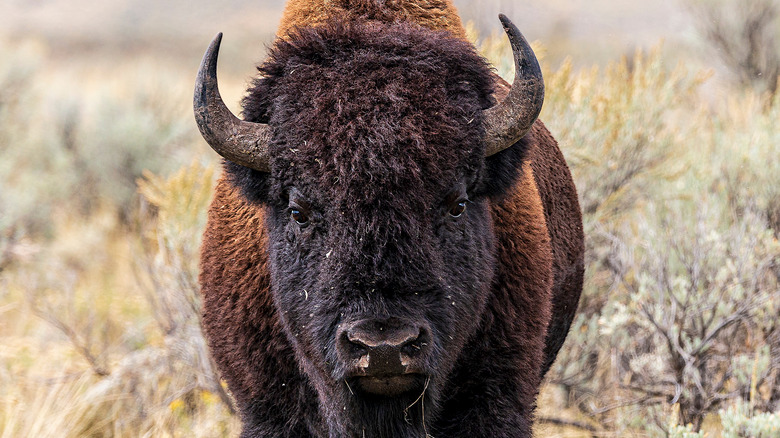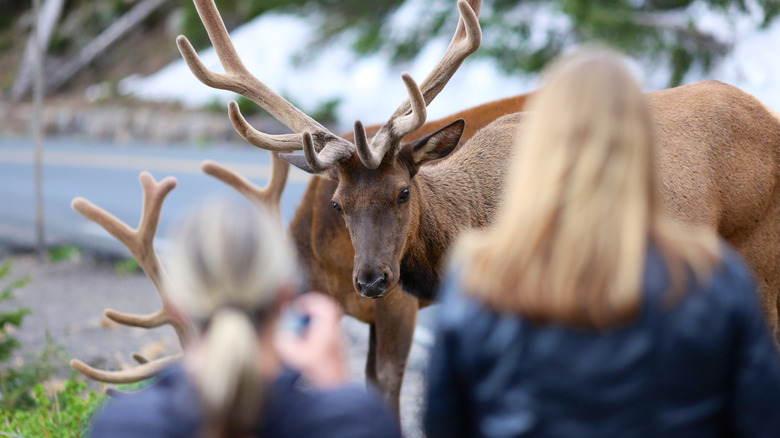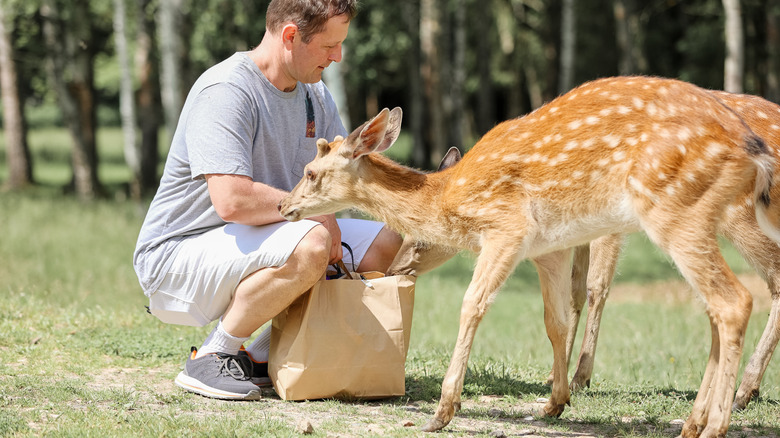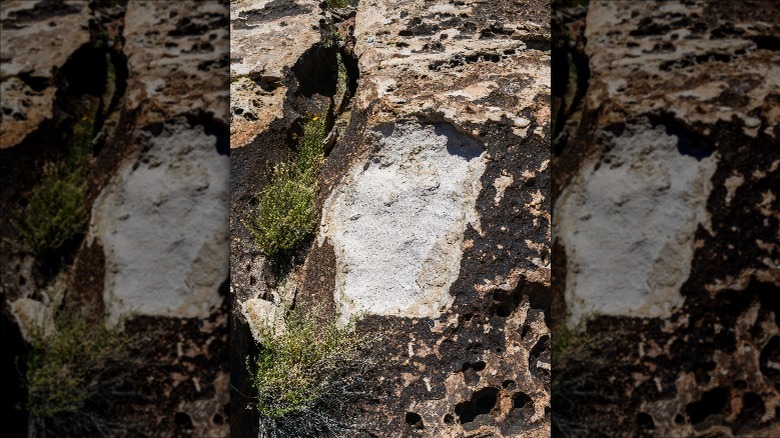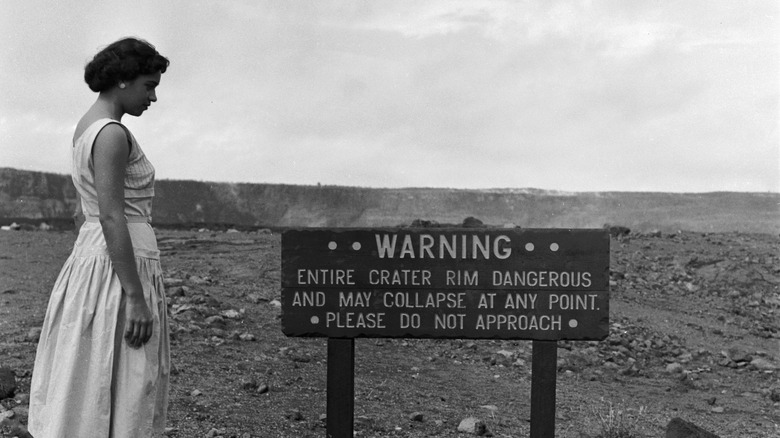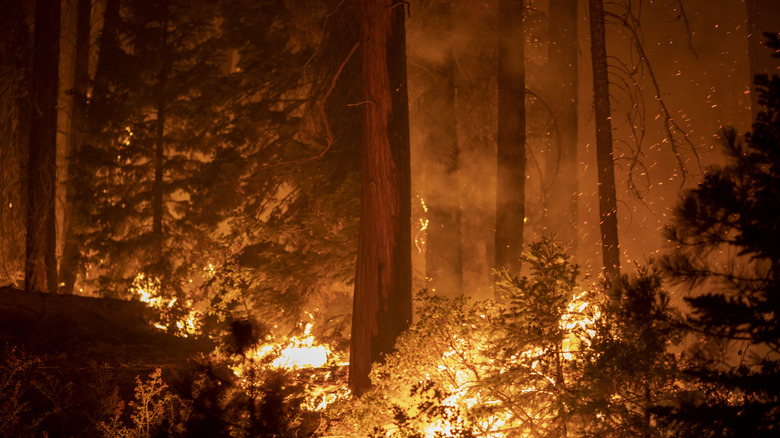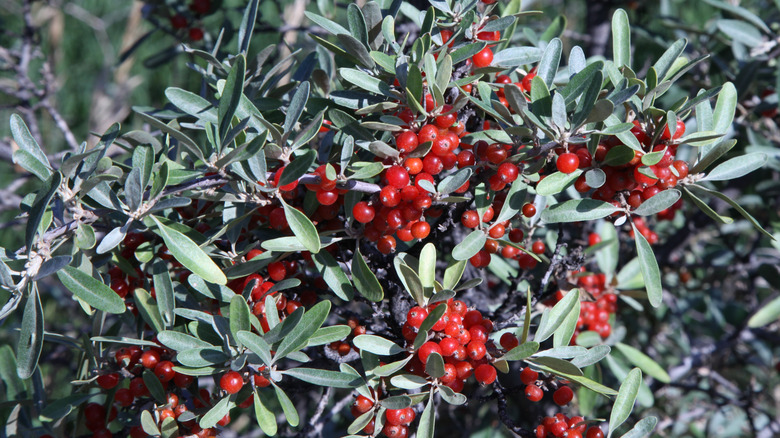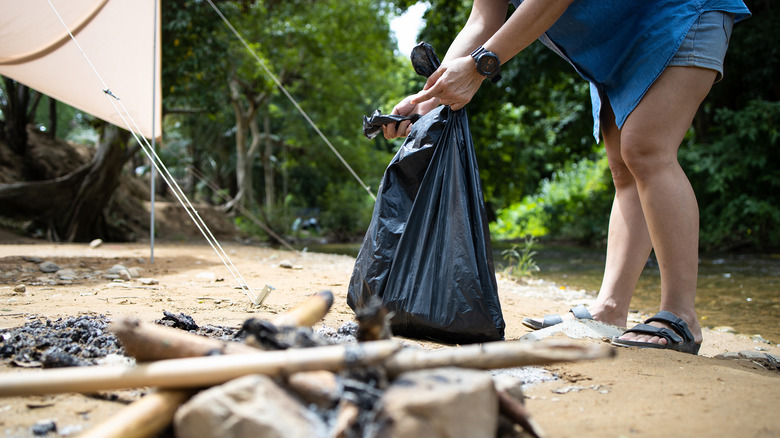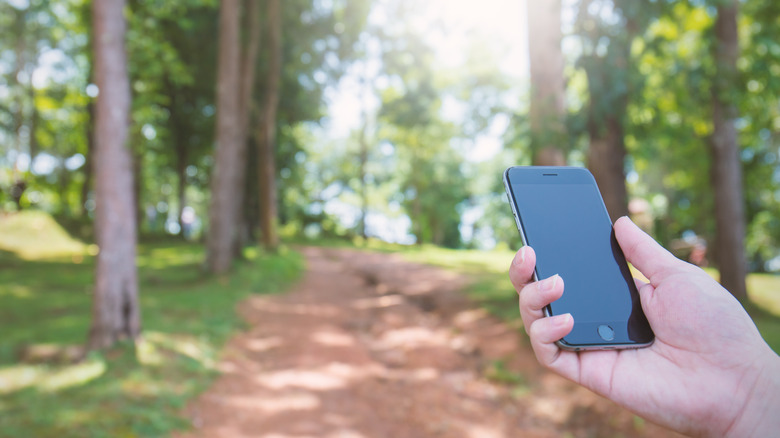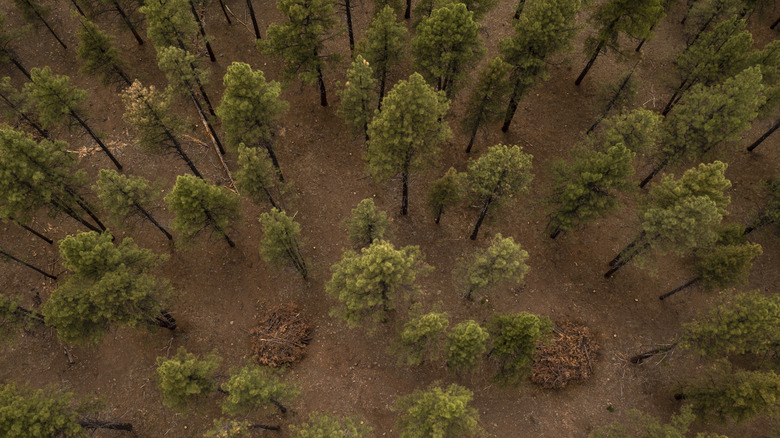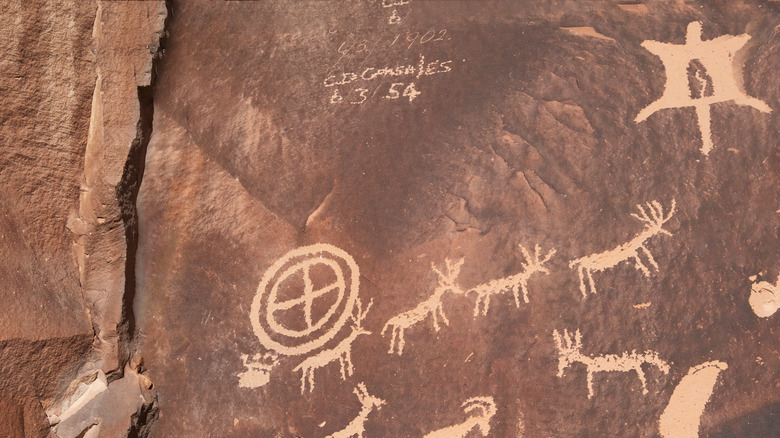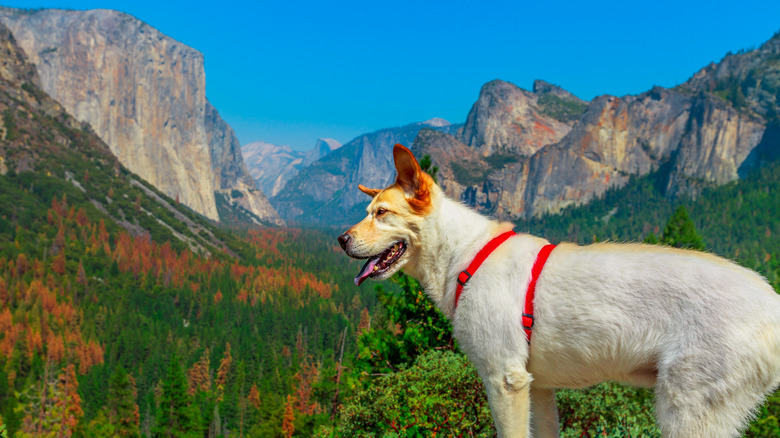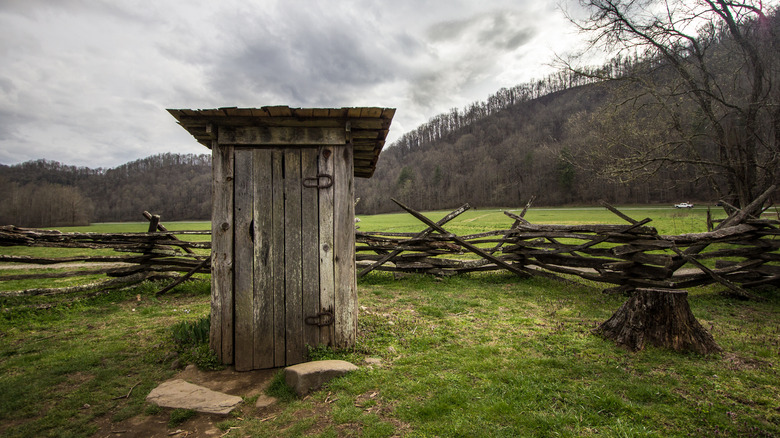Things You Should Never Do In A National Park
After Manifest Destiny-ing across the country and taking land from the people who already lived there, in 1872, Congress decided that maybe some of that land should be set aside so it didn't get ruined by colonization and capitalism. According to the National Park Service, on March 1 of that year, Yellowstone National Park was founded, the first of its kind in the world, set aside "as a public park or pleasuring-ground for the benefit and enjoyment of the people." There are now more than 400 national park sites across the country.
So since your tax dollars pay for them and they are expressly for your enjoyment, that means you can do what you like in a national park, right? Wrong. If you're headed into some of the most gorgeous natural areas of the country, there are things you should never do to make sure both you and the animals are safe, and that the parks stay beautiful for future generations.
Interact with the wildlife
Fair warning: a cute animal is going to die in a minute. Or rather, it already died, but you are about to learn about it. And while it is very sad, it is also the most effective illustration of why when you go to a national park you should never, ever interact with the wildlife. The most obvious reason is the animal could attack you, causing serious injury or spreading disease. But seemingly harmless animals need to be left alone as well, for their own safety. Even if you think an animal needs your help, leave it.
The latter type of interaction happened in Yellowstone National Park on May 9, 2016, the Washington Post reported. On a day when the high hit 50 degrees Fahrenheit, two tourists saw a newborn bison and decided, for whatever reason, that it must be cold. So they picked it up and put it in their car.
Far from saving the not-at-all-cold baby animal, their actions led directly to its death. After being handled by people, the calf's mother rejected it. "Park rangers tried repeatedly to reunite the newborn bison calf with the herd. These efforts failed," a Yellowstone statement said. "The bison calf was later euthanized because it was abandoned and causing a dangerous situation by continually approaching people and cars along the roadway." So once you stop crying, swear that you will never, ever touch any of the wild animals in a national park.
Feed the wildlife
While it might seem obvious you shouldn't try to pet the wildlife in national parks or, you know, pick an animal up and put it in your car (you'd think that would be obvious, but anyway) it might seem like less of a big deal if you feed the animals. After all, what's a few sunflower seeds or lettuce leaves? Those are natural; it's not like you're leaving Twinkies for the squirrels or anything.
Well, bad news. While it might seem like feeding is a good thing that will keep animals in the parks alive, in reality, it leads to them being very dead. The National Parks Service goes so far as to call feeding wildlife "a form of animal cruelty." The Idaho Statesman reported in 2021 that a perfectly healthy young black bear had to be put down once it became clear it had become "food-conditioned," in other words, it got so much access to human food at campsites in Montana's Glacier National Park that all the normal tricks to scare it away no longer worked. While that case might have involved campers being lax with their food security rather than feeding the bear on purpose, in 2018, 9 News reported a fox in Grand Teton National Park was also euthanized because humans had been feeding it so much that it would go right up to people looking for a treat.
It's not just traditionally dangerous animals either: The NPS explains that a deer who was used to being fed killed a child in Yosemite when the boy didn't give it his sandwich.
Take a souvenir
If you go on vacation and you don't buy a souvenir, did you really even go? And sure, all the national parks have overpriced gift shops with plenty of touristy tat in them for you to bring home, but that's not really in keeping with the tone of your trip. Surely, the best souvenir you can acquire in a national park is a bit of the park itself.
Well, according to the United States Department of Justice, if you did that and got caught, you'd be charged with violating 16 U.S.C. § 470ee, which "prohibits removal, defacing, or trafficking in archeological resources on public or Indian lands." Depending on how valuable the thing you took was or the amount of damage caused, you could be looking at one to two years in jail and a $10,000 to $20,000 fine. And if for some reason you don't learn your lesson and do it again, those penalties jump to five years and $100,000.
And those aren't empty threats. In 2018, 60-year-old Gary Womack of Kentucky got 15 months for thefts from various government-owned lands, including Channel Islands National Park, per National Parks Traveler. To be fair, he definitely knew what he was doing was wrong, since he got the artifacts by digging up Native American graves. The thieves who looted Petersburg National Battlefield in 2016 at least didn't disturb the graves there – at least the ones that were marked – but CNN reports they dug many large holes in the battlefield and didn't even try to cover their tracks.
Ignore the signs
If you're the outdoorsy type, the kind who likes sleeping on the ground and eating freeze-dried food and being as far away from other people as possible, then you probably aren't big on being told what to do either. The Man might have a say over your life in the city, but in the middle of a national park, you make your own rules. You don't need to listen to any of these signs put there by the Government telling you "Stay on the path" or "Warning: Falling rocks" or "No seriously, the bears will eat you." You are an outdoorsman, and you know what you are doing.
Well, ignoring signs in a national park is a great way to end up lost, trapped, or dead. In 2014, four people in as many days injured themselves after they ignored the same signs at a popular natural pool beneath a waterfall in Yosemite, per National Parks Traveler.
And as another reminder to never try to interact with the wildlife, Yellowstone National Park is full of big, clear signs warning people not to get anywhere near the animals, like, you know, the giant bison. The ones with horns. This didn't stop an Australian tourist in 2015, who The Salt Lake City Tribune reports was gored in 2015 when he got too close. Nor is he alone, as every year people are injured when they ignore the signs and decide to try to be a buffalo whisperer.
Be casual with fire
If you haven't noticed, half of the United States is on fire for a good four or five months of the year now, like clockwork. And that half also happens to have some of the most famous and beautiful national parks in the country. So while it's one of the highlights of going camping in a national park to start a cozy campfire at the end of the day ... try not to burn down a state or two while you're at it?
Fortunately, the National Parks Service has you covered when it comes to how to correctly have fun with fire on government land with helpful guides and videos. And, of course, they have a very helpful and memorable IP in the form of Smokey Bear, who is all about getting campers to accept personal responsibility for keeping the parks inferno-free. Sadly, not everyone listens. SFGate reported that in August 2013, a hunter was in the Stanislaus National Forest when he started a campfire to heat up some food – despite there being a burn ban in place. The resulting blaze lasted 9 weeks, covered 400 square miles, and destroyed 11 homes.
While climate change has made the chance of major fires worse, it's always been a problem in the parks. "The Report of the Director of the National Park Service to the Secretary of the Interior for the Fiscal Year Ended 1919" covered the many fires in Yosemite caused by campfires, cigarettes, and cigars. And it notes that 14 people were tried and fined for leaving their campfires unattended.
Eat berries or mushrooms
If you forget to pack enough trail mix when hiking in a national park and find yourself getting puckish, well, you'll just have to deal with it and remember to bring more next time. What you should not do, no matter how much your tummy grumbles, is grab yourself an al fresco snack supplied by the great outdoors itself. Eating the wrong mushroom or berry is a great way to find yourself very dead, or at least ill.
Smokey Bear Ranch, located in Glacier National Park, highlighted eight common poisonous berries found in the United States, including holly, mistletoe, and yew. Depending on which ones and how much someone eats, side effects range from an upset stomach to incontinence to brain damage to death. One berry not mentioned on the Smokey Bear Ranch list was the red baneberry, which National Parks Traveler says is "widely distributed" around the country, including Mount Baker-Snoqualmie National Forest. They note that the berry's toxicity depends on the time of year, and a child risks cardiac arrest eating even just two berries.
It's not just berries: all plants and mushrooms should be avoided unless you are an expert. In 1985, the AP reported on a man who died after eating poisonous water hemlock while visiting Yellowstone National Park. He and his friends had mistaken it for a different, edible plant.
Bring plastic with you
If you like the environment enough to take the time and effort to visit a national park, then you are probably at least a little worried about climate change. Everyone should be trying to cut down on their reliance on single-use plastics anyway, but when packing for a trip to the great outdoors, you definitely need to leave all the plastic at home. The plastic situation in America's national parks is out of hand, and getting worse.
Somehow, even in a deeply politically divided country like the United States, a 2022 poll by the nonprofit Oceana (via Environmental Health News) found that 82% of U.S. voters across all parties supported banning the sale of single-use plastic items at National Parks. Considering each visitor to a national park each year leaves an average of over 2 pounds of garbage behind them, this change could make a big impact on that number.
U.S. PIRG record that in 2013, a full half of the solid waste disposed of in Yellowstone National Park that year was plastic water bottles. Of course, not all that rubbish was purchased in the park: plenty of people will have brought their own plastic bottles and other plastic things to the park only to leave them behind, even if they did put them in the right bin. And not all of it does, not by a long shot. Plastic is now found virtually everywhere in nature, including in far too high amounts in the wilderness of U.S. national parks.
Rely on your phone
While getting away from it all sounds great in theory, being disconnected from your phone can seem kind of impossible. That's why many visitors to national parks rely on their phones in more ways than one when they are in the wilderness, all of which can lead to serious issues or even death.
First, there are people who think their phones can replace maps. According to Outside, in 2019, only 50% of Yellowstone National Park had cell service, and even many of the areas that did get it, the signal was not very strong. And if something happens to you out there, that means might not be able to summon help. A family died in Sierra National Forest in 2021, per NBC News. They knew they were in trouble as their bodies shut down from heat exhaustion and dehydration, but the signal wasn't strong enough for their desperate calls and texts for rescue to go through. (On the other hand, if you get lost and do have cell service, answer your phone. KXAN reported that a lost hiker in San Isabel National Forest ignored calls from rescuers because he didn't recognize the number.)
Finally, don't rely on your phone to snap pictures for the 'gram so much that you forget basic safety. The New York Post reported in 2016 that a man fell to his death in Acadia National Park while taking a picture of the sunset, while a teenager getting a selfie in Yosemite in 2018 also fell and died, per ABC News.
Fly a drone
Drones might not be as ubiquitous as smartphones, but it's a technology that is fast becoming both more exciting and cheaper. As more and more people buy drones for their own use and start uploading dozens of YouTube videos of aerial shots of their backyards, many of them are going to want to get some more impressive views of nature. Where better to take your drone than the wide-open spaces of a national park?
According to the government, many other places. Drone U records that the anti-drone policy has been around for national parks since way back in 2014. And as you'd expect from a pro-drone site, they aren't big fans of this rule. They quote drone law expert Brendan Schulman: "It's very broad in that it sweeps in every national park-controlled location, including things like beaches and forests where there really aren't the same sensitivities to noise, and where model airplanes have been allowed for decades."
And if you ignore this rule? Not only can the rangers take your drone, but you could be out $5,000 in fines and even find yourself in jail for six months. This doesn't mean people haven't tried to get away with it anyway. Sierra: The Magazine of the Sierra Club reports that drone enthusiasts were caught by the NPS over 2,000 times from 2015 to 2020. If you are desperate, there is a Special Use Permit available, although Drone U says these are "nearly impossible" to get.
Vandalize
Not all priceless art ends up in museums. Some of the oldest and most important artworks in all of the U.S. can be found on random rocks in national parks. Native Americans often used these rocks as their canvas to paint or etch images of animals, people, or geometric shapes. Short of encasing all of them in plexiglass, it is just understood that if you are in a national park and stumble on one of these incredible and ancient works of art, you should just admire it and move on. As the Mona Lisa would not be improved by you giving her a face tattoo before the Louvre guards tackle you, these indigenous artworks do not need you to etch your initials, the initials of the person you'll break up with in two months, and the date on them. Yet people do it all the time.
In 2016, Reuters reported that tourists had etched their names so deeply into rocks found in one of the most popular areas at Utah's Arches National Park that there was probably no way to reverse the damage.
At the end of 2021, tourists with the same very creative idea scratched their names and the date on rocks in Big Bend National Park, per CNN. However, in this case, it wasn't just the rocks, but the ancient petroglyphs on them that were "irreparably damaged." The National Parks Service defines that kind of damage as "cultural violence."
Let your dog off the leash
While you might think you are not allowed to bring your dog to any national park, because of all the animals and other people and various dangers, in actuality, plenty of the parks are dog friendly. (But not all of them! Research the rules for the specific one you're headed to before you go, like on the National Parks Foundation website.)
Even the ones who are happy for you to bring your best pooch friend have rules, though. Lots of them, according to the Code of Federal Regulations' "Title 36: Parks, Forests, and Public Property" chapter on the National Parks Service; although almost all of them are reasonable and ones that dog parents will have encounter any number of other places. One of the most important is that your dog needs to always be on a leash no longer than 6 feet. Seems simple enough, but anyone who's had a dog knows plenty of dog owners who think leash laws don't apply to their fur baby because he or she is just so well behaved. This is a serious rule, though. If a ranger sees your dog running unattended, they can impound it; if your dog attacks an animal, they may go so far as to put it down.
Other no-nos are letting your dog park incessantly, leaving your pet alone (even if they are tied up), or leaving their poop all over the place.
Assume you can poop anywhere
Look, when you head to the great outdoors, you know you won't have any of the creature comforts of home. But even the biggest camping fan would probably say that if they could bring one thing with them, it would be indoor plumbing. If you head deep enough into a national park, you might be lucky to find an outhouse.
As the National Parks Service points out on their page solely devoted to pooping in their parks (yes, really), many places you can hike and camp don't have any sort of restroom. While peeing is various levels of difficulty depending on what equipment you are dealing with, everyone has the same issues when it comes to pooping. But just because you are alone in the wilderness with no one to see or judge you doesn't mean you can just poop anywhere. So picking a spot to poop is an art and very important for the environment and the health and safety of other humans and the wildlife.
Tips from The Dyrt include being 200 feet from any water sources, ideally on high ground so not even rainwater will foul a nearby stream, and a location that gets good sunlight to help the waste decompose faster. Then dig a decent-sized hole to deposit your waste in, and cover it back up with dirt and leaves when you are done. Never leave toilet paper behind, not even buried in the hole with the poop. And if you don't bring toilet paper? The NPS reminds you that if you grab a few leaves, double-check they are not poison ivy. Ouch.
